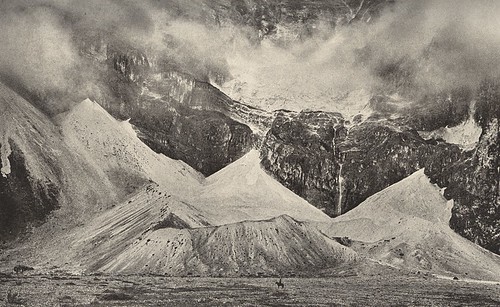When Joseph Rock crossed over the high pass into Konkaling territory, his Tibetan guides shouted "La Rgellah!" - 'the gods are victorious' and burned juniper twigs as an offering. Rock and his party then descended and began his circumambulation of the three sacred peaks, Chandorje, Shenrezig and Jambeyang. 
His Muli lama guide was still terrified, and kept pleading with him to turn back, hoping Rock would be satisfied now that he had actually seen the peaks. But the explorer continued on, noting in his scholarly way the many different kinds of plant and animal life. There were giant rhubarb plants, primroses and strange bright red flowers he had never seen before.
He shot a pair of snow pigeons, and this brought protests from his escort of local Tibetans who objected to his harming the animals.
"To me this seemed peculiar for they themselves do not hesitate to kill a pious pilgrim, while both they and the pilgrim are devoutly circumambulating the sacred peaks!".
His shooting also flushed out a couple of local Konkaling women hiding behind some boulders, who feared for their lives.
"Any shots heard hereabouts are always supposed to have been spent on sending some individual into the spirit world, since no one wastes a shot and powder on useless pigeons as we had done."
Then, camping on the southern slopes of Jambeyang, Rock came face to face with the notorious killer himself, the bandit leader Drashetsongpen, on a pilgrimage around the peaks, "perhaps in expiation of his heinous crimes".
Rock noted his gang of thirty robbers, the "scum of the outlaws" with "sullen faces hinting at loot and murder". They sat down on rocks and shared some much fingered yak cheese. They made no conversation except for Drashi informing Rock that he need not fear as he had given orders for him to remain unharmed.
Rock moved on in the rain, shooting a wapiti [mountain elk], and skirted the sacred lakes he called the Russo Tso - now known as the Niunai Hai [Milk Lake] and much visited by trekkers coming up from Luorong Pasture.
 "Sea Dragon's Snout" in 1928
"Sea Dragon's Snout" in 1928
Sea Dragon's Snout in 2002
He circuited round the eastern side of Shenrezig, just as trekkers now do on the kora, crossed the second wearying pass at 16,000 feet and descended to the small Tsengu Gompa monastery - the Chonggu Gompa of today. As I have already written, he was not impressed with its black and dingy rooms, the greasy unwashed lamas or the stares of the few other wretched 'bandit pilgrims. He stayed three days at this lonely and dismal spot, "where no white man had ever visited":
"I felt buried in these mountain fastnesses, icebound on all sides. The monastery was the rendezvous of all the outlaws and bandits ..."
He photographed the peaks, especially Shenrezig, which he likened to a huge white throne.

He noticed that there were nuns in residence at the Tsengu Gompa - toothless old women, six feet tall who were almost indistinguishable in their thick greasy garments from the lamas until they spoke. Then, heading back towards Muli, he caught his first real glimpse of Jambeyang in a cloudless sky, and was moved to write:
"In a cloudless sky before me rose the perrless pyramid of Jambeyang, the finest mountain my eyes ever beheld. The sky was greenish black. The snowy pyramid was grey, but the apexes of both it and Shenrezig suddenly turned a golden yellow as the sunrise kissed them."
Some people say this description inspired James Hilton's description of the scared mountain of Karakal in his book Lost Horizon, that gave us the notion of Shangri-La:
"It was to the head of the valley that his eyes were led irresistibly, for there, soaring into the gap, and magnificent in the full shimmer of the moonlight, appeared what he took to to be the loveliest mountain on earth. I was an almost perfect cone of snow, simple in outline as if a child had drawn it .. it was so radiant, so poised, that he wondered for a moment if it were real at all.
The mountain showed again, great at first, then silver, then pink as the earliest sunrays caught the summit."
Joseph Rock returned to Muli and in later weeks tried to make two more visits to the Konkaling peaks. His second visit was a washout because of the monsoon rains - he saw nothing. His third visit was cancelled at the last minute when the Muli king heard the bandit chief Drashi had sworn to kill Rock if he returned. After Rock's last visit the gods of the Konkaling peaks been angered, according to the outlaw, because they had sent a huge hailstormthat had ruined that year's crops.
Rock yielded to the advice of the Muli king and stayed away. "Knowing their cruelty and determination, we took the hint," he wrote.
"And thus the land of the Konkaling outlaws is again closed and their mountains remain guarded as of yore."

Jambeyang and Shenrezig in 1927.

The same mountains today.




No comments:
Post a Comment